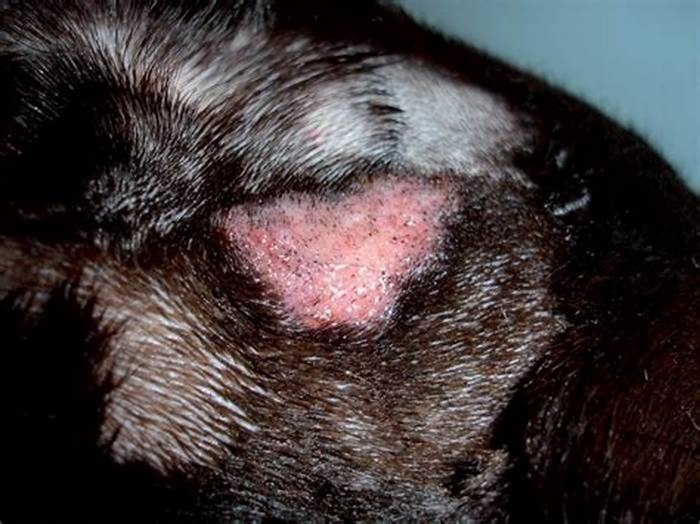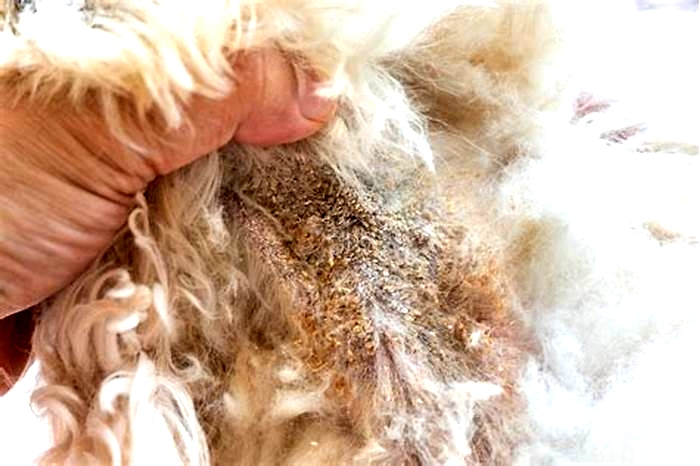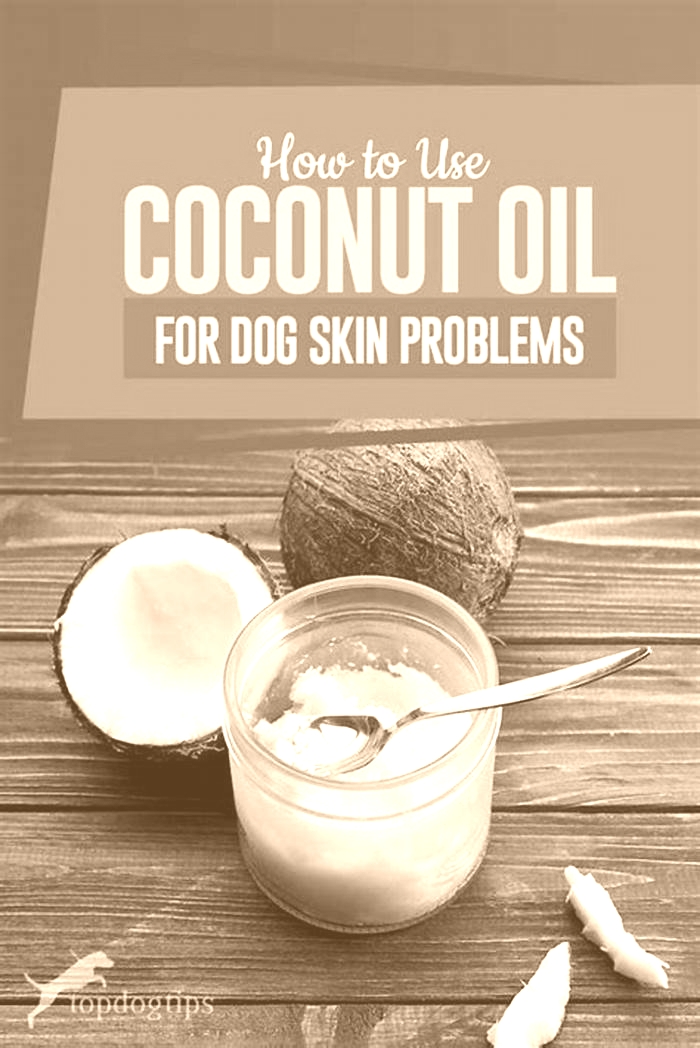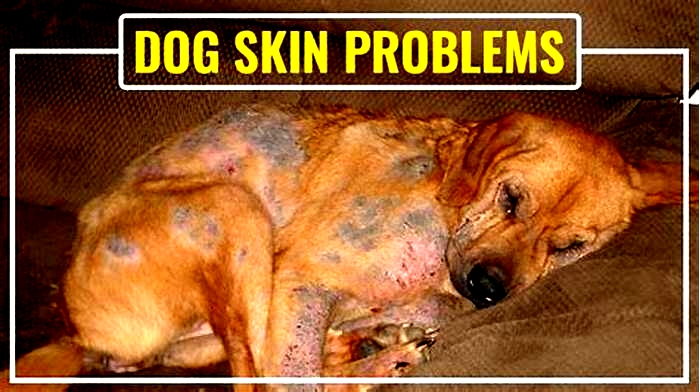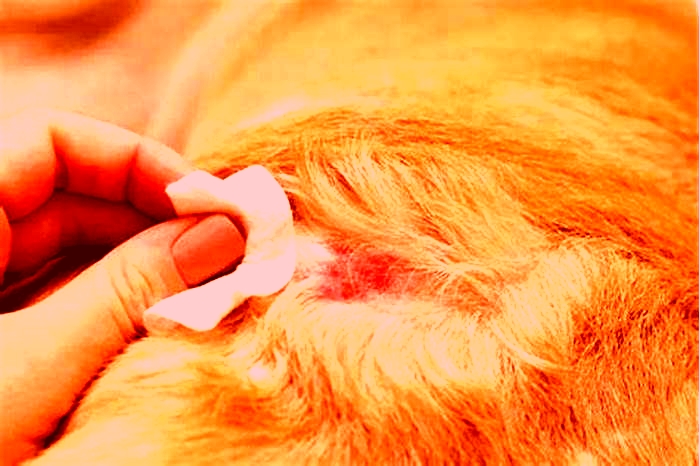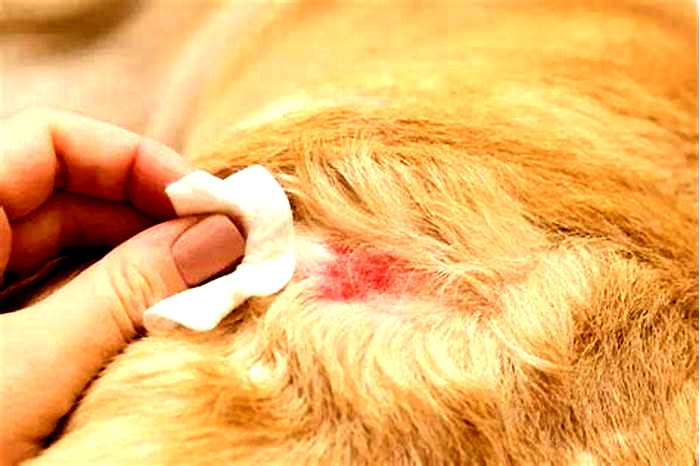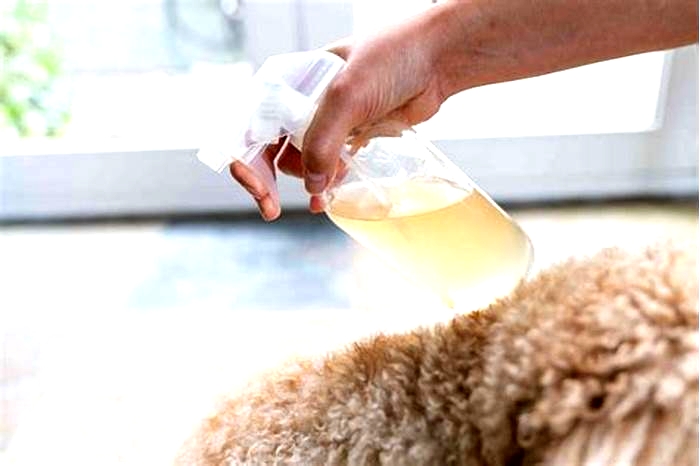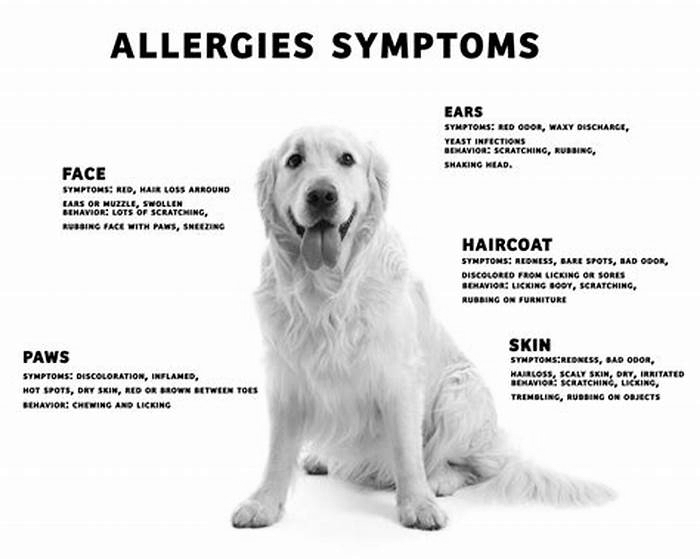What does a bacterial skin infection look like on dogs
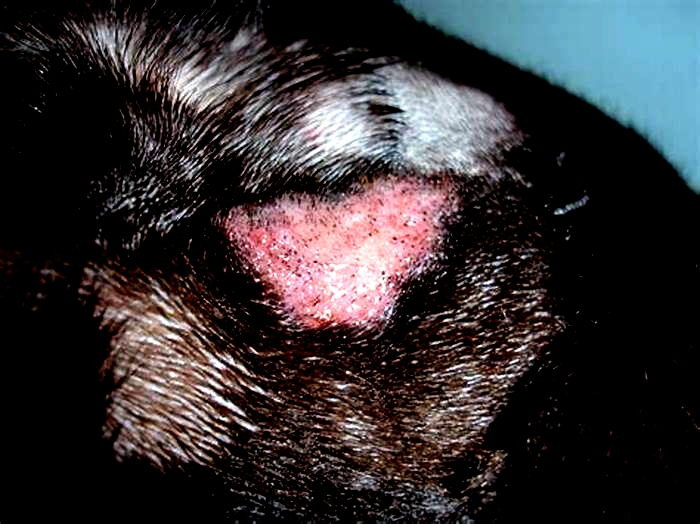
Skin Infections in Dogs: Bacterial Infections
Symptoms of Skin Infection in Dogs
Clinical signs associated with a skin infection in dogs can vary depending on the specific cause, but early manifestations of the skin condition can be similar regardless of the cause. Commonly seen symptoms are itchiness, hair loss, and generalized discomfort. Skin flaking and crusting can also be seen in some cases of skin infection.
Generalized redness, erythema, and skin inflammation can also be observed in dogs with skin infections. Untreated and severe cases will eventually emit a pungent or foul odor, and can even be fatal to highly susceptible and immunocompromised animals.
Types of Skin Infection in Dogs
Skin infection in dogs can be generally classified into 2 types: bacterial and fungal. Several bacterial and fungal species can invade and penetrate the skin barrier and cause infection in canines. Inflammation and breaks on the skin barrier can increase the risk of these microorganisms taking over, leading to an infection.
Its important to determine what type of skin infection an affected animal has because the treatment for both types is different. Medications that can control and eliminate bacterial organisms will have no effect against fungal infections, and likewise, anti-fungal medications are ineffective against bacterial skin infections.
Proper identification and diagnosis are important to have a specific and targeted treatment for your dogs skin infection.
Common Bacterial Skin Infection Causes in Dogs
Pyoderma is the most common bacterial skin infection in dogs. This bacterial skin infection is characterized by the presence of purulent (pus-like) discharge from the skin and is commonly caused by several species of bacteria.
Pyoderma in dogs is differentiated based on the tissues of the skin involved in the disease. Infections that only affect the topmost layers are called superficial pyoderma, and pyoderma that infiltrates and infects the deeper layers of the skin are called deep pyodermas. Superficial pyoderma accounts for the majority of pyoderma cases in dogs.
Most superficial pyoderma cases occur spontaneously and often present with a localized skin lesion. Loss of hair, or alopecia, is typically seen in superficial pyoderma cases, along with erythema (redness) and purulent discharge. Superficial pyoderma lesions tend to cause severe discomfort and will result in affected dogs trying to scratch or bite on the lesions, making the condition worse. The most common bacteria that causes this type of pyoderma is Staphylococcus pseudointermedius.
Deep pyodermas, on the other hand, usually have a triggering cause. Oftentimes, deep pyodermas result from untreated superficial pyodermas. Some cases of deep pyoderma are caused by the same bacterial species, but other organisms like E. coli, Proteus sp., and Pseudomonas sp. can also cause infection. Deep pyoderma cases affect the deeper portions of the hair follicle which results in erythema, hyperpigmentation, swelling, and skin ruptures. Affected areas of the skin are often painful and swollen.
Diagnosing & Treating Bacterial Skin Infections in Dogs
As mentioned, treatment for skin infections in dogs will ultimately depend on proper identification and diagnosis. The best way to diagnose skin infection in canines is through skin cytology, bacterial and/or fungal culture, and identification. Several methods like skin scraping, smear biopsy, and acetate cytology have proven effective in determining whether a skin infection is bacterial or fungal in nature. Identification of specific bacterial or fungal causes will involve culturing and isolating the bacteria taken from skin samples.
Most bacterial skin infections respond well to antibacterial medications. Localized and solitary bacterial infections can easily be treated with topical medications such as antibacterial creams and ointments. A more generalized infection will often need systemic antibacterial therapy for treatment.
Similarly, fungal infections are mostly treated with topical medications such as ointments or medicated shampoos, depending on how widespread the lesions are. Systemic antifungal medications are usually only prescribed in severe cases of fungal skin infections because of their potential liver and kidney side effects.
Read more:
Skin Infections in Dogs: Fungal & Yeast Infections
Common Skin Parasites in Dogs
My Dog Wont Stop Licking His Paws - Help!
Need to speak with a veterinarian regarding your dogs skin infection or another condition?
Click here to schedule a video consult to speak to one of our vets. You can also download the FirstVet app from the Apple App Store and Google Play Stores.
Pyoderma in Dogs
What Is Pyoderma in Dogs?
Pyoderma is the medical term for a bacterial skin infection and it is one of the most common diseases in dogs. Dogs are at increased risk for pyoderma due to many features of their skin. For example, a dogs skin has a thinner outer barrier and possesses a higher pH than many other species, making it easier for normal bacteria living on the skin to overgrow and for other bacteria to invade.
Damage to the normal skin barrier also predisposes dogs to pyoderma. This is often seen with pets who scratch and lick their skin. Any area of the skin can be infected depending on the type of pyoderma affecting your dog.
Types of Pyoderma in Dogs
Surface pyodermaaffects the outer skin layer (epidermis). You may see pink, irritated skin, and hair loss. Surface pyoderma includes:
Pyotraumatic dermatitis (hot spots): This develops rapidly and is very itchy.
Intertrigo: Infection of skin folds, a common condition in short-muzzled breeds, such as English Bulldogs.
Bacterial overgrowth syndrome (BOGS): The dogs skin is greasy, itchy, and smells. It is most seen on the underside of the body.
Superficial pyoderma affects the epidermis and part of the hair follicles. You may see redness, circular crusts, bumps, and hair loss. Superficial pyoderma includes:
Impetigo (puppy pyoderma): This is an infection that is usually due to a puppys developing immune system and affects areas with little hair, like the belly.
Affected puppies are usually healthy overall and in mild cases may only need a topical treatment. Adult dogs that are immunocompromised can also develop impetigo.
Superficial bacterial folliculitis (SBF) and superficial spreading pyoderma: A dogs coat may have a moth-eaten appearance due to widespread hair loss. This happens in all breeds, but Shetland Sheepdogs, Border Collies, Australian Shepherds, and Collies may experience especially severe redness and irritation.
Mucocutaneous pyoderma: This type of pyoderma leads to the overproduction of mucus in the skin. The lips, nose, skin around the eyes, vulva, prepuce, and the area around the anus are most commonly affected. German Shepherds, Bichon Friss, and poodles may be predisposed.
Deep pyoderma affects lower skin layers (dermis, subcutis): This can occur if superficial pyoderma goes untreated or skin follicles rupture. You may see swelling, purple-looking areas, or draining tracts of infection in addition to redness, crusting, and hair loss. Deep pyoderma includes:
Furunculosis: This condition is commonly seen between a dogs toes, but it can occur elsewhere. In rare cases, a condition called post-grooming furunculosis can occur 24 to 48 hours after bathing or intense brushing, causing pain and fever.
Acne: This is more common among young dogs, and involves inflammation of hair follicles (usually around the chin and mouth) that may become infected with bacteria.
German Shepherd deep pyoderma: The outer thighs, groin, and trunk are likely to be affected.
Lick granuloma: Your dog may develop a skin lesion from licking the top surface of its lower legs. This may stem from a bacterial infection or another issue.
Callus pyoderma: This condition presents itself as dark, thickened skin over pressure points that are infected.
Symptoms of Pyoderma in Dogs
Dogs with pyoderma may have red and itchy skin. You may also see circular crusts, flakiness, areas of hair loss, and pimple-like lesions. If your dog has been scratching or biting its skin, your pet may have visible sores and pus.
If your dog has suffered from itchy skin for several weeks or more, you may see the skin get darker and thicker. Dogs with deep pyoderma may have swelling and draining tracts of infection, and experience low energy, loss of appetite, trembling, or other signs of pain.
Causes of Pyoderma in Dogs
Pyoderma usually occurs secondary to another illness or disease process. It may occur as a complication of:
Allergies to fleas, environmental allergens, or a food ingredient
A parasitic skin infection, like Sarcoptes or Demodex mites
An endocrine disease, such as hypothyroidism or Cushings disease
Immune disorders or immunosuppression
A bacterial infection may need to be cleared before additional testing for the underlying cause can be completed. The most common bacterial infection that causes pyoderma is Staphylococcus pseudintermedius, which is responsible for more than 90 percent of cases. This type of bacteria normally inhabits the skin, but it can increase in number and cause problems when the skin barrier is damaged or unhealthy.
Other causes include Staphylococcus schleiferi, Staphylococcus aureus (which in rare cases can spread to humans), as well as invaders like E. coli, Pseudomonas, Actinomyces, Nocardia, and others.
How Veterinarians Diagnose Pyoderma in Dogs
In order to diagnose your dog with pyoderma, your veterinarian will need to start with a physical exam. Based on the presence of certain lesionssuch as pustules (bumps that look like pimples) the veterinarian may be comfortable diagnosing your pet based on what he or she determines from the physical exam. Diagnostic testing is usually necessary, and may include:
Treatment of Pyoderma in Dogs
Use of an Elizabethan collar (or e-cone) is recommended if your pet is licking or biting its skin. This will prevent reinfection and allow the skin to heal.
Medications your veterinarian may recommend include:
- Antibiotics: Commonly used oral antibiotics include cephalexin, Simplicef, Clavamox, and clindamycin.
- Cefovecin (brand name, Convenia)is an injectable antibiotic that is administered by a veterinarian and lasts for two weeks. Other antibiotics may be required if your pet has a resistant infection, or a deep infection with rod-shaped bacteria.
- Anti-itch medication: Options include Apoquel, Cytopoint, and an anti-inflammatory dose of steroids. Your veterinarian will determine whether these medications are safe options for your pet.
If you do not notice an improvement (lesions drying up, reduced itchiness, etc.) after a few days of treatment, please call your veterinarian. Culture and sensitivity may be needed to determine which antibiotic will be effective.
Treatment of Pyoderma in Dogs
Topicals your veterinarian may recommend include:
- Medicated shampoo: This shampoo may contain antibacterial and antifungal ingredients, such as chlorhexidine, ketoconazole, and/or miconazole. Benzoyl peroxide is an antibacterial ingredient often used in cases of acne. If your pet has recurrent infections, your veterinarian may recommend long-term use of a medicated shampoo.
- Medicated spray, mousse, or ointment: You may be instructed to spray or rub an antimicrobial product on your pet when they are dry. If your pet has recurrent infections, your veterinarian may recommend long-term use of one of these products.
- Clip and clean: For dogs with hot spots and other localized skin issues, the veterinary staff will clip the hair surrounding the affected area to prevent bacteria in the hair from causing a reinfection, and to allow air exposure. Then they will use a gentle antiseptic wash, such as 2 percent or 4 percent chlorhexidine solution to clean the area.
- Epsom salt foot soaks: Soaking affected paws in Epsom salt solution (two tablespoons per liter of warm water) may be recommended if your pet has inflammation and infection of its paws.
Recovery and Management of Pyoderma in Dogs
Re-check appointments with your veterinarian will ensure that your dogs infection has completely cleared before its antibiotic treatment has ended. Treatment may need to be continued for 7 to 14 days past when their skin appears normal, so please do not stop the antibiotics before a full course of treatment has been completed. Ending antibiotic treatment too early can contribute to the development of antibiotic resistance.
Infection often needs to be cleared before your veterinarian can begin investigating the underlying cause of the pyoderma. It is important to determine the underlying cause, whether it be allergies, Cushings disease, hypothyroidism, or another illness, so your dog doesnt experience frequent relapses of pyoderma.
Length of Treatment for Pyoderma in Dogs
The length of treatment will vary depending on the type and severity of your pets pyoderma. Many cases of superficial pyoderma require treatments lasting three to four weeks. Deep pyoderma may require treatment that lasts for months. Do not stop treatment without the direct recommendation of your pets veterinarian.
Pyoderma in Dogs FAQs
Is pyoderma in dogs contagious to humans?
It is rare for humans to catch pyoderma from their dogs, though it is possible (e.g., Staphylococcus aureus). Staphylococcus pseudintermedius, the most common cause of canine pyoderma, does not lead to disease in humans.
Is pyoderma in dogs considered a serious condition?
Pyoderma is typically easily treated on an outpatient basis with good outcomes. However, deep pyoderma can be more serious and in rare and extreme cases, require hospitalization.
Featured Image: iStock.com/momcilog
References
Gortel K. Recognizing Pyoderma. Veterinary Clinics of North America: Small Animal Practice. 2013;43(1):1-18. doi:10.1016/j.cvsm.2012.09.004
Poli G. MiniVET Guide: Companion Animal Medicine. Gerardo Poli; 2016.
Gortel K. Recognizing Pyoderma. Veterinary Clinics of North America: Small Animal Practice. 2013;43(1):1-18. doi:10.1016/j.cvsm.2012.09.004
Poli G. MiniVET Guide: Companion Animal Medicine. Gerardo Poli; 2016.
WRITTEN BY
Stephanie Gaddam, DVM, MPHVeterinarian
Dr. Stephanie Gaddam graduated from the North Carolina State University College of Veterinary Medicine in 2018. She worked in small animal...

